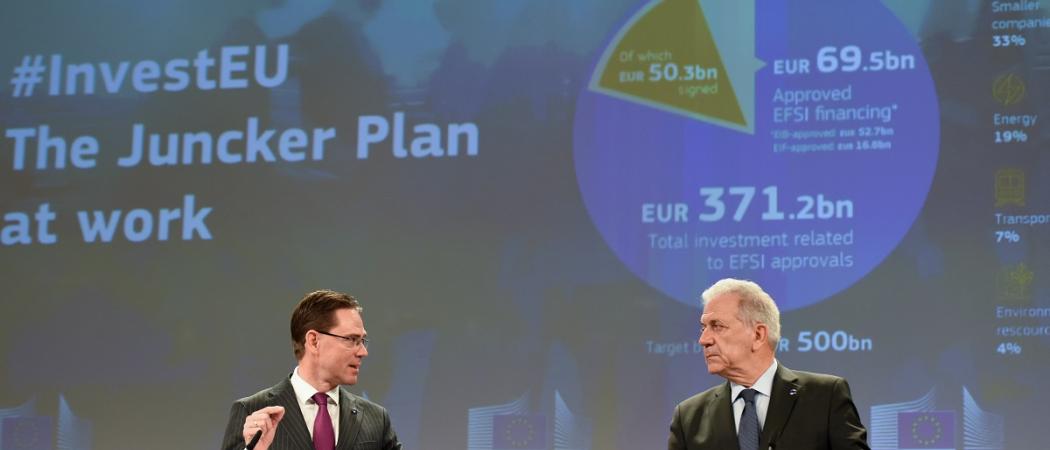Almost one third of Juncker Plan innovation loans went where they weren’t needed and claims the plan “mobilised” an additional €335 billion were “overstated,” says the European Court of Auditors. EIB chief disputes the auditors’ methods, and Commission says they lack "the full picture."

EU commissioners Jyrki Katainen and Dimitris Avramopoulos at a press conference on the impact of the Juncker Plan. Photo: Jennifer Jacquemart, European Commission
The European Commission and European Investment Bank (EIB) "overstated" the effectiveness of the Juncker Plan and gave nearly a third of its infrastructure and innovation loans to projects that did not need EU help, says the European Court of Auditors (ECA) in a report published today.
The auditors dispute claims by the commission and the EIB that the €65.5 billion loans handed out under the Juncker Plan "mobilised" €335 billion of additional investment from other sources, saying some of this investment would have occurred anyway.
The findings cast a shadow over the Juncker Plan's forthcoming successor, InvestEU, which the commission claims will "trigger" €650 billion of additional investment using €38 billion in loan guarantees, with €11.25 billion earmarked for research and innovation. The European Parliament gave InvestEU the green light in Strasbourg on 16 January.
The ECA report, which was unusually blunt in its criticism, provoked testy responses from the EIB and the Commission. They criticised the auditors’ methods of assessing whether the programme worked or not “We’re not convinced that the court showed the full picture,” said Commission spokeswoman Annika Breidthardt.
€33.5 billion in loan guarantees
The Juncker Plan is the flagship policy of commission president Jean-Claude Juncker, set up at the start of his term in 2014 to tackle the investment gap that emerged following the financial and economic crisis, which began in 2008. The idea was to use loan guarantees to secure financing for infrastructure and other projects that would otherwise be too risky to invest in.
The plan established the European Fund for Strategic Investments (EFSI), to provide €33.5 billion in loan guarantees, using €26 billion from different bits of the EU budget and €7.5 billion of EIB resources.
Recent projects financed by the Juncker Plan include a research and development programme at a French dairy cooperative and an “investment platform” for developing energy efficient buildings in the Czech Republic.
Money would have been invested anyway
According to the auditors’ report, the Juncker Plan did raise finance to support “substantial additional investment.” However, the €335 billion claim is an exaggeration because it ignores the fact that some of this money would have been invested anyway, even if EFSI had never existed.
While the auditors could not say exactly how much would have been provided by other lenders, an anonymous ECA survey found almost a third of loan recipients under the infrastructure and innovation element of the Juncker Plan had other sources of finance available to them. The EIB loans were preferred either because they were cheaper or had later repayment deadlines.
In a press conference after the ECA report was published, EIB President Werner Hoyer cast doubt on the survey’s findings. “If you ask the clients, you get sometimes enthusiastic answers on the positive side, and you see some that believe after they have been on their knees to get our loans for a long time and have received the loans afterwards, they said ‘of course we could have done it ourselves,’ which, in some cases, I would doubt."
In a written reply to the auditors, the commission and the EIB say their estimate was of “the extent to which EFSI can be linked to new investment,” while “the exact cause and effect relationship in inducing financing is generally difficult to demonstrate and cannot be conclusively proven."
Yet a press release they issued in July last year asserted that the Juncker Plan had exceeded its €315 billion target and, “has mobilised €335 billion in additional investment across the EU since July 2015."And EIB group president Werner Hoyer was quoted as saying, “Triggering €315 billion in new, additional investment - most of it from the private sector - was never going to be an easy task. We demonstrated that it can be done […..].”
ECA recommendations
The Juncker Plan was originally intended to run from 2014 – 2018, but at the end of 2017 was extended until 2020, with the aim of mobilising a total of €500 billion of public and private investment from 2014 - 2020.
InvestEU is then intended to build on the experience of the Juncker Plan, with the aim of attracting €650 billion of investment from 2021 – 2027.
The ECA makes five recommendations for the future of the Juncker Plan:
- Invest in higher risk projects;
- Avoid competition between EFSI and other EU financial instruments;
- Improve assessments of whether projects could have been financed by other means;
- Improve estimates of additional investment “mobilised”;
- Improve the geographical spread of EFSI.
In the reply to the auditor's report, the commission and the EIB claim to have already addressed the second and third recommendations. But after the report's publication, Breidthardt appeared to contradict this response, claiming that “most of the court's recommendations for improvement have already been addressed by EFSI 2.0, which came into force in December 2017, and via our InvestEU proposal.”
At an ECA press conference held on 28 January, before the report came out, the auditors said claims that the commission had addressed most of the recommendations were untrue.
Although the recommendations refer to the Juncker Plan, they will resonate through InvestEU, due to the similarities between the two programmes.
Editor's note: This article was updated 30 January to include additional comments from the EIB and the European Commission.




 A unique international forum for public research organisations and companies to connect their external engagement with strategic interests around their R&D system.
A unique international forum for public research organisations and companies to connect their external engagement with strategic interests around their R&D system.